TeZukA, Sadler's Wells | reviews, news & interviews
TeZukA, Sadler's Wells
TeZukA, Sadler's Wells
If it does nothing else, this dance show should whet your appetite for manga
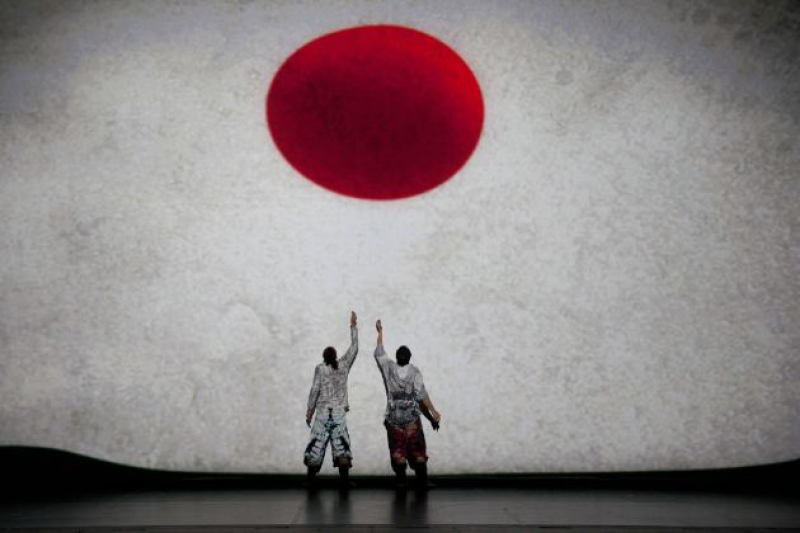
Edit, edit. Inside TeZukA there’s a charming, elliptical, hugely stylish piece begging to be sliced and trimmed into focus - just as the manga master Osamu Tezuka must have daily occupied himself with as he prepared his graphic cartoons. The visuals in Sidi Larbi Cherkaoui’s piece are spectacular video animations of Tezuka’s fastidiously drawn scenes, the kerpows and the Zen landscapes, Black Jack, the transfigured rabbit.
Whether it whets the appetite for what dance can do is a more moot point. At two and a quarter hours long, this is a baggy experience, but it has many elegant things in it fashioned by Cherkaoui, who has often proved one of the best metteurs en scène in the dance world. Everything is arranged nicely: the trio of oriental musicians silhouetted upstage left on their little dais, the painting table downstage left, where a wizened little man in black is joined by a beautiful model on whose bare back he gravely paints Japanese characters.
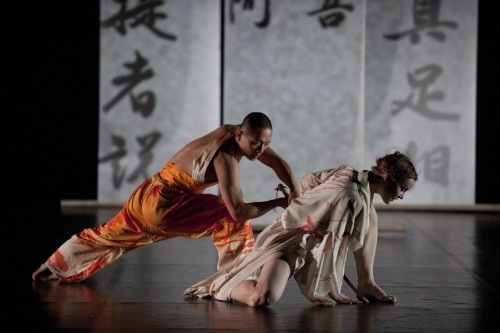 Surrounding the stage, scrolls of ivory paper rise and fall, sometimes to be flooded with projections of manga drawings, or columns of Japanese writing. A scroll of paper, too, feeds a bumpy little tune through a music box, wound by hand by the negligibly kimonoed Hannah Peel, who has a back like an alabaster wall.
Surrounding the stage, scrolls of ivory paper rise and fall, sometimes to be flooded with projections of manga drawings, or columns of Japanese writing. A scroll of paper, too, feeds a bumpy little tune through a music box, wound by hand by the negligibly kimonoed Hannah Peel, who has a back like an alabaster wall.
Nitin Sawhney provides gentle, musing melodies, weaving time and cultures together, Japanesey, Indianish, a pleasing atmospheric blend. And in the middle of the stage is what Cherkaoui - a Tezuka devotee - has made of his communion with his idol.
Delightfully dressed characters echoing Astro Boy (red wellies), or Ayako the imprisoned girl, or Black Jack, the mercenary surgeon, or Tezuka himself, in beret and glasses. A pair of amorously tangling boys who may or may not indicate Tezuka’s struggles with his forbidden sexuality. Two Shaolin monks, lean, wiry elves whizzing across the stage in somersaults and frenzied kung-fu bouts, exactly like cartoons are drawn.
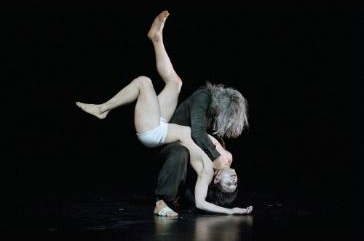 This intriguing array of characters, though, tend to be milling about more than one would like, considering the exact planning and purposefulness of the cartoons from which they’re derived, which scroll behind them on the huge video wall, showing us manga newcomers what a high design skill and imaginative discipline is demanded by these dark, portentous volumes. You can’t call them comics, even if they look like comics. Not when one of the stories is about a girl locked in the basement by her own family.
This intriguing array of characters, though, tend to be milling about more than one would like, considering the exact planning and purposefulness of the cartoons from which they’re derived, which scroll behind them on the huge video wall, showing us manga newcomers what a high design skill and imaginative discipline is demanded by these dark, portentous volumes. You can’t call them comics, even if they look like comics. Not when one of the stories is about a girl locked in the basement by her own family.
But Cherkaoui lacks an equal gift for crispness. There’s a tiresome amount of lecturing, about Japan’s susceptibility to apocalyptic events, in 1945 and 2011, about Tezuka’s life, about bacteria, used as a link to Tezuka’s medical training and interests (and which I think, though I can't be sure thanks to the heavy accents and Sadler's Wells's skewed sound system, Cherkaoui is attempting to apply as a metaphor to the spreading of suspicion and prejudice that resist healing).
Still, you can just ignore the words, watching the rest of the stage, the musicians plucking and tapping on their zithers, violins and bells, the mysterious screeds of calligraphy, the coming and going of unearthly miracles of light and space machinated by Willy Cessa (lights), Taiki Ueda (video) and Sasa Kovacevic (costumes), each in their area contributing one of the best parts of the production.
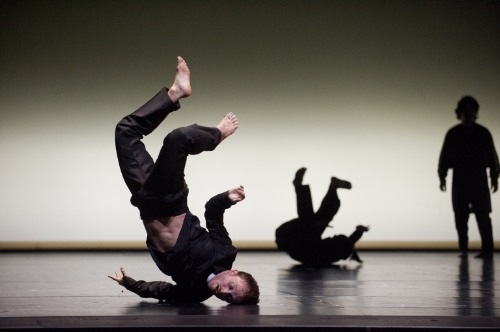 For while Cherkaoui has a rare ability, evident in many of his works, for creating fresh, unselfconsciously limber movement, he doesn't exploit the characters' dance potential - is it deliberate? Astro Boy wobbles around in his red boots as if his wiring was awry; Black Jack and Ayako both talk at us, parading costumes rather than embodying characters. Much of it seems hesitant whimsy, bathetic where it deals with Tezuka's death, leaving the characters wobbling uncertainly around without a master.
For while Cherkaoui has a rare ability, evident in many of his works, for creating fresh, unselfconsciously limber movement, he doesn't exploit the characters' dance potential - is it deliberate? Astro Boy wobbles around in his red boots as if his wiring was awry; Black Jack and Ayako both talk at us, parading costumes rather than embodying characters. Much of it seems hesitant whimsy, bathetic where it deals with Tezuka's death, leaving the characters wobbling uncertainly around without a master.
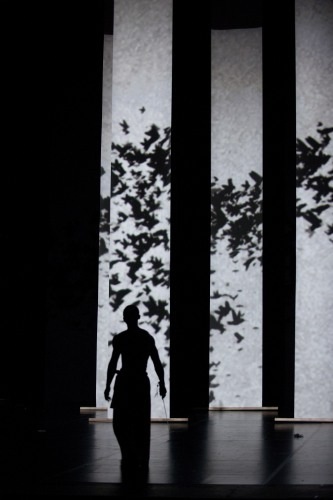 But then amid the whimsy there have been gripping fragments of theatre. A forest of hanging scrolls become illuminated with letters, which, as a kodo drum rumbles in crescendo, shiver, seem to fall off the towers, then bleed and crumble into dust, before a black video tidal wave washes over the people standing fatalistically below. At the other end, witty and delicious, is a bit of Cherkaouian foolery where a girl unfolds and folds and crumples a sheet of cartoons - and a man lying next to her exactly replicates the changing states of the abused paper, his body folding and lurching into impossible scrunches.
But then amid the whimsy there have been gripping fragments of theatre. A forest of hanging scrolls become illuminated with letters, which, as a kodo drum rumbles in crescendo, shiver, seem to fall off the towers, then bleed and crumble into dust, before a black video tidal wave washes over the people standing fatalistically below. At the other end, witty and delicious, is a bit of Cherkaouian foolery where a girl unfolds and folds and crumples a sheet of cartoons - and a man lying next to her exactly replicates the changing states of the abused paper, his body folding and lurching into impossible scrunches.
Between such scenes there are enough longueurs and outbreaks of body painting to stifle enjoyment. Earlier this year I was held in a spell by Cherkaoui’s Apocrifu, on the serious topic of religious texts, but if he’s trying to argue that Tezuka’s manga is equally deep and meaningful, he would do better to follow the master to the pictures, not the words. Innocence and freshness are Cherkaoui’s strengths; a bit more of them, a lot less of the earnestness, would do me.
- TeZuKa is at Sadler's Wells Theatre, London, till Saturday
- Read theartsdesk's feature and manga art gallery
Add comment
The future of Arts Journalism
You can stop theartsdesk.com closing!
We urgently need financing to survive. Our fundraising drive has thus far raised £49,000 but we need to reach £100,000 or we will be forced to close. Please contribute here: https://gofund.me/c3f6033d
And if you can forward this information to anyone who might assist, we’d be grateful.

Subscribe to theartsdesk.com
Thank you for continuing to read our work on theartsdesk.com. For unlimited access to every article in its entirety, including our archive of more than 15,000 pieces, we're asking for £5 per month or £40 per year. We feel it's a very good deal, and hope you do too.
To take a subscription now simply click here.
And if you're looking for that extra gift for a friend or family member, why not treat them to a theartsdesk.com gift subscription?
more Dance
 'We are bowled over!' Thank you for your messages of love and support
Much-appreciated words of commendation from readers and the cultural community
'We are bowled over!' Thank you for your messages of love and support
Much-appreciated words of commendation from readers and the cultural community
 R:Evolution, English National Ballet, Sadler's Wells review - a vibrant survey of ballet in four acts
ENB set the bar high with this mixed bill, but they meet its challenges thrillingly
R:Evolution, English National Ballet, Sadler's Wells review - a vibrant survey of ballet in four acts
ENB set the bar high with this mixed bill, but they meet its challenges thrillingly
 Like Water for Chocolate, Royal Ballet review - splendid dancing and sets, but there's too much plot
Christopher Wheeldon's version looks great but is too muddling to connect with fully
Like Water for Chocolate, Royal Ballet review - splendid dancing and sets, but there's too much plot
Christopher Wheeldon's version looks great but is too muddling to connect with fully
 iD-Reloaded, Cirque Éloize, Marlowe Theatre, Canterbury review - attitude, energy and invention
A riotous blend of urban dance music, hip hop and contemporary circus
iD-Reloaded, Cirque Éloize, Marlowe Theatre, Canterbury review - attitude, energy and invention
A riotous blend of urban dance music, hip hop and contemporary circus
 How to be a Dancer in 72,000 Easy Lessons, Teaċ Daṁsa review - a riveting account of a life in dance
Michael Keegan-Dolan's unique hybrid of physical theatre and comic monologue
How to be a Dancer in 72,000 Easy Lessons, Teaċ Daṁsa review - a riveting account of a life in dance
Michael Keegan-Dolan's unique hybrid of physical theatre and comic monologue
 A Single Man, Linbury Theatre review - an anatomy of melancholy, with breaks in the clouds
Ed Watson and Jonathan Goddard are extraordinary in Jonathan Watkins' dance theatre adaptation of Isherwood's novel
A Single Man, Linbury Theatre review - an anatomy of melancholy, with breaks in the clouds
Ed Watson and Jonathan Goddard are extraordinary in Jonathan Watkins' dance theatre adaptation of Isherwood's novel
 Peaky Blinders: The Redemption of Thomas Shelby, Rambert, Sadler's Wells review - exciting dancing, if you can see it
Six TV series reduced to 100 minutes' dance time doesn't quite compute
Peaky Blinders: The Redemption of Thomas Shelby, Rambert, Sadler's Wells review - exciting dancing, if you can see it
Six TV series reduced to 100 minutes' dance time doesn't quite compute
 Giselle, National Ballet of Japan review - return of a classic, refreshed and impeccably danced
First visit by Miyako Yoshida's company leaves you wanting more
Giselle, National Ballet of Japan review - return of a classic, refreshed and impeccably danced
First visit by Miyako Yoshida's company leaves you wanting more
 Quadrophenia, Sadler's Wells review - missed opportunity to give new stage life to a Who classic
The brilliant cast need a tighter score and a stronger narrative
Quadrophenia, Sadler's Wells review - missed opportunity to give new stage life to a Who classic
The brilliant cast need a tighter score and a stronger narrative
 The Midnight Bell, Sadler's Wells review - a first reprise for one of Matthew Bourne's most compelling shows to date
The after-hours lives of the sad and lonely are drawn with compassion, originality and skill
The Midnight Bell, Sadler's Wells review - a first reprise for one of Matthew Bourne's most compelling shows to date
The after-hours lives of the sad and lonely are drawn with compassion, originality and skill
 Ballet to Broadway: Wheeldon Works, Royal Ballet review - the impressive range and reach of Christopher Wheeldon's craft
The title says it: as dancemaker, as creative magnet, the man clearly works his socks off
Ballet to Broadway: Wheeldon Works, Royal Ballet review - the impressive range and reach of Christopher Wheeldon's craft
The title says it: as dancemaker, as creative magnet, the man clearly works his socks off
 The Forsythe Programme, English National Ballet review - brains, beauty and bravura
Once again the veteran choreographer and maverick William Forsythe raises ENB's game
The Forsythe Programme, English National Ballet review - brains, beauty and bravura
Once again the veteran choreographer and maverick William Forsythe raises ENB's game

Comments
...
I have heard that this